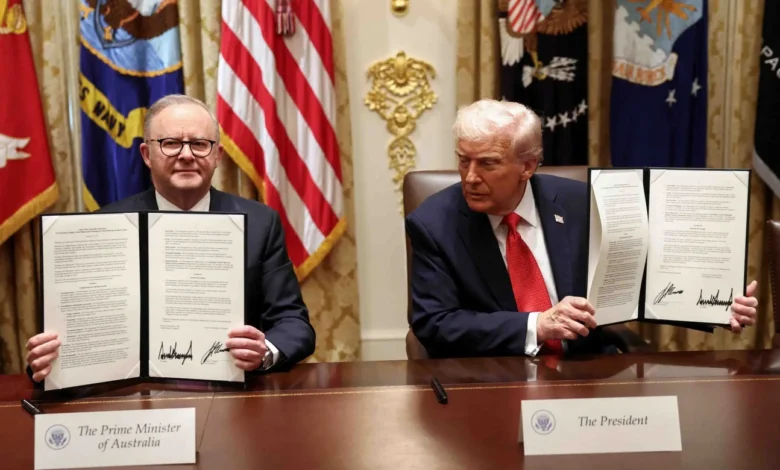
US Struggles to Break China’s Rare Earth Dominance
China dominates the global refined rare earths market with over 90% of total output. Trump struggles to break this monopoly despite his push to find other suppliers. These rare earth elements are actually abundant in nature. The biggest problem lies in separation and purification, which makes China’s grip on processing capabilities especially concerning. The United States still relies heavily on China and imports 70% of its rare earth compounds and metals from 2020 to 2023.
These materials play a vital role in modern technology. To name just one example, each F-35 fighter jet needs more than 900 pounds of rare earth elements, which shows their crucial role in advanced military systems. Goldman Sachs projects that a mere 10% disruption in industries that depend on these elements could eliminate $150 billion from US economic output. This reality has made reducing dependency a national security priority, as China continues to tighten its export controls. China’s processing capabilities reached 99 percent of global heavy rare earth elements until 2023. The country also controls almost all the world’s dysprosium and terbium supply. Australia owns the world’s fourth-largest deposits and has boosted its production over the last several years. However, experts believe the US faces major hurdles as it tries to develop alternative supply chains quickly.
China tightens grip on rare earths exports
Image Source: Reuters
China tightened its control over rare earth exports on October 9, 2025. The country substantially expanded restrictions on these critical minerals by adding five new elements and dozens of refining technologies to its control list. Exporters must now get special licenses to ship these materials abroad. This strategic move came before planned talks between Presidents Donald Trump and Xi Jinping, showing China’s readiness to utilize its dominance during negotiations.
New licensing rules restrict global access
Companies worldwide must now apply for export licenses from China’s Ministry of Commerce before shipping rare earth materials internationally. The licensing system requires exporters to identify controlled items and specify their dual-use item control numbers in customs declarations. The process usually takes 45 days but could take longer if authorities need technical assessments or ground inspections.
China has introduced extraterritorial provisions that reach beyond its borders. From December 1, 2025, overseas entities must get Chinese export licenses for rare earth products made outside China if they use Chinese materials or technologies related to mining, smelting, separation, or recycling. This rule applies to products with just 0.1% by value of Chinese-origin rare earths.
The regulations clearly state that military end-users will be denied applications. This effectively bans exports for defense purposes. Applications for advanced semiconductors and AI technologies with potential military uses will need case-by-case approval.
Heavy rare earths face stricter controls
The original April restrictions covered seven rare earth elements, mostly heavy rare earths vital to defense technologies: samarium, gadolinium, terbium, dysprosium, lutetium, scandium, and yttrium. China added five more elements in October: holmium, erbium, thulium, europium, and ytterbium. Export controls now cover all but one of these 17 recognized rare earth elements.
These restrictions target elements where China’s monopoly stands strongest. China controls 99.8% of global refining capacity for heavy rare earths. Alternative sources barely exist. Until 2023, China factored in 99% of global heavy rare earth processing. A Vietnamese facility produced minimal output but closed due to tax disputes.
Global supply chains felt immediate and severe effects. Major automakers scramble to secure supplies before the November 8 implementation deadline. Industry analysts warn these controls could create multi-quarter supply bottlenecks in vital sectors.
China’s dominance stems from decades of investment
China built its rare earth dominance gradually. The country made rare earth industry development a priority through continuous state-led investment initiatives since the late 20th century. Environmental and economic feasibility concerns that affected Western projects did not hamper this strategy.
China often operates at a loss across the rare earth supply chain to keep prices artificially low. The cost of neodymium-praseodymium dropped 20% between January and July 2024. China increases exports whenever non-Chinese firms try developing new mining capacity. This makes alternative mines commercially unviable.
The government uses annual production quotas to maintain control. China strengthened its oversight in July 2025 with new measures. Companies must now report monthly production data and track product flow. Violations result in fines or reduced quotas.
Industry consultants report China’s dominance across the value chain. The country handles 70% of global rare earth mining, 85% of refining capacity, and about 90% of rare earth metal alloy and magnet production. This complete control makes it extremely difficult for the United States and its allies to reduce their dependency.
Why rare earths matter to US defense and tech

Image Source: The Telegraph
Rare earth elements serve as the invisible backbone of America’s most advanced defense systems and technologies. These elements power everything from stealth fighters to electric vehicles. Their strategic value goes way beyond the reach and influence of commercial use. China’s dominance in processing creates a critical weakness.
Critical role in F-35 jets, missiles, and EVs
America’s premier fighter aircraft, the F-35 Lightning II, needs about 418 kg of rare earth elements for each unit. These materials make advanced weapons targeting systems, radar, and laser technologies work. The military needs these technologies to keep air superiority. Naval vessels need even bigger quantities. An Arleigh Burke-class destroyer uses about 2,600 kg of rare earths. A Virginia-class submarine needs roughly 4,600 kg.
Military applications exist in advanced weapons platforms of all types:
- Tomahawk missiles and precision-guided munitions need rare earth magnets for guidance systems
- Predator unmanned aerial vehicles use hundreds of neodymium magnets
- Radar systems use rare earths to focus electromagnetic energy
- Night vision equipment can’t work without europium and related elements
Electric vehicles represent a faster growing sector that needs these elements. Tesla stayed away from rare earth magnets at first but started using them in the Model 3 in 2017. Notwithstanding that, many manufacturers now work to reduce their reliance. BMW has created magnet-free motors while Tesla wants to remove rare earths completely in next-generation models.
Dependence on Chinese processing facilities
The US faces a processing bottleneck that weakens its security. China factored in 99% of global heavy rare earth processing as of 2023. This creates an almost total reliance for critical defense materials. The US shipped most domestically mined rare earths to China for processing until early 2024. This shows how deep the dependency runs.
The US relied on China for 70% of its rare earth compounds and metals imports between 2020 and 2023. This weakness exists whatever the mining capacity. The US mines about 15% of global supply at Mountain Pass, California, but lacks facilities to turn raw materials into usable components.
The United States has no heavy rare earths separation capability. Recent investments have helped, but America’s new processing capabilities remain tiny compared to China’s reliable infrastructure.
Effect on US manufacturing and breakthroughs
Manufacturing problems already show. America’s F-35 upgrade program faces major delays and cost overruns. The Block 4 modernization will finish in 2031—five years later than the original plan. Many factors cause these delays, but China’s control of critical materials creates ongoing supply problems.
The Department of Defense has put over $440 million into building domestic supply chains since 2020. They want to develop a complete mine-to-magnet supply chain by 2027. MP Materials’ expanded production will only create 1,000 tons of neodymium-boron-iron magnets yearly by 2025. That’s nowhere near China’s 2018 production of 138,000 tons.
Industry experts say building independence would take 10-15 years of steady investment. American manufacturers remain vulnerable during this transition. The International Energy Agency says global demand for these materials must grow tenfold by 2030 to meet clean energy goals. This makes competition for limited supplies even more intense.
Trump signs deals but struggles to catch up
Image Source: The Diplomatic Insight
President Trump signed several international agreements to secure rare earth supplies as China tightens its control. These efforts will take years to show results. The administration now focuses on bilateral deals with allies and strategic investments in domestic production.
US-Australia $8.5B rare earths agreement
Trump and Australian Prime Minister Anthony Albanese signed a groundbreaking framework agreement at the White House on October 20, 2025. The deal sets aside AED 3.67 billion for rare earth projects across both countries over the next six months. This funding supports a larger AED 31.21 billion pipeline of “ready-to-go” projects that will expand Australia’s mining and processing capabilities. The U.S. will invest in a 100-ton-per-year gallium refinery in Western Australia as part of this agreement. Trump’s statement that “in about a year from now, we’ll have so much critical mineral and rare earths” seems optimistic given typical industry timelines.
Pakistan and other nations offer alternatives
Pakistan has emerged as another supply source. The country shipped its first rare earths delivery to U.S. Strategic Metals on October 2, 2025, under a AED 1835.97 million agreement. This shipment contained antimony, copper concentrate, and rare earth elements like neodymium and praseodymium. Experts warn that Pakistan’s capacity is nowhere near sufficient. Their partnership follows a three-phase development plan over a decade, and significant results aren’t expected before 2035.
Pentagon and Ex-Im Bank fund domestic projects
The Department of Defense has put AED 1982.85 million into critical minerals projects and wants to create a complete mine-to-magnet supply chain by 2027. The Pentagon made its biggest move by investing AED 1468.78 million to become MP Materials’ largest shareholder, which runs the only U.S. rare earth mine in California. This public-private partnership comes with price guarantees and a commitment to buy magnets from MP’s planned manufacturing facility.
The Export-Import Bank has issued seven letters of interest that total AED 8.08 billion for critical minerals projects in Australia. These financial tools will speed up the development of resources needed for defense systems and advanced technologies.
America still lags behind China’s decades-old capacity. Experts believe achieving full independence could take 10-20 years of continuous investment.
US faces roadblocks in building supply chain
Image Source: Discovery Alert
America faces tough obstacles in building its own rare earth supply chain, despite heavy investments. These roadblocks go far beyond money and could hurt national security goals.
Lack of refining capacity and skilled labor
The US operates just one rare earth refining facility today. This plant produces only 1.3 kilotons of neodymium-praseodymium metal alloy. China’s capacity dwarfs this output, growing 5% in 2024 to 270 kilotons. The US lacks any domestic facilities that can process heavy rare earth elements like dysprosium and terbium.
The workforce shortage makes this processing gap worse. The world outside China has roughly two dozen experts in rare earth separation and refining. China employs thousands of trained specialists. New facilities risk delays and cost overruns without experienced staff, as several US projects have shown.
Environmental and regulatory hurdles
Rare earth processing creates major environmental challenges, especially radioactive waste management. The public often strongly opposes the waste from cracking and leaching processes used in refining.
Projects need 3-5 years to get permits under current rules, and many face extra delays. To cite an instance, Lynas Rare Earths stopped building its heavy rare earth processing facility in Seadrift, Texas because of wastewater disposal permit problems.
Experts say a decade is needed for independence
Industry experts believe breaking free from Chinese processing will take 10-15 years of steady investment. The Government Accountability Office found that rebuilding domestic rare earth processing would cost billions. Heavy rare earth processing presents the most important technical hurdles.
The lack of resources, technical complexity, and environmental challenges create unavoidable delays, even with faster funding. Building refining and processing capabilities could take 10-15 more years due to long development cycles.
Can allies help the US reduce dependency?
Image Source: Discovery Alert
Allied nations are creating new ways for the United States to reduce China’s control over rare earth supply chains. Each strategic collaboration brings its own benefits but faces big challenges to implement.
Australia’s Lynas and Browns Range projects
Australia has emerged as America’s most significant rare earth partner. The country attracted AED 235.00 million in 2024, which is a big deal as it means that it represents 45% of global exploration investment. Australia now has 89 active rare earth exploration projects, nowhere near Canada’s 18 and Brazil’s 13. Lynas Rare Earths reached a major milestone in May 2025. They became the first company outside China to produce commercial quantities of dysprosium oxide. Their Mount Weld mine has about 2 million tons of rare earth oxide reserves.
The Browns Range project in Western Australia is another chance to expand production. The site has Australia’s highest-grade dysprosium and terbium orebody. Once operational, it could provide 8% of global dysprosium-terbium demand.
Japan and Vietnam’s joint R&D efforts
Japan’s strategic collaboration with Vietnam is 5 years old. They focus on the Dong Pao mine, Vietnam’s largest rare earth deposit with over 5 million tons in reserves. Both countries signed agreements that cover mining operations capable of producing 10,000 tons yearly.
Pakistan’s strategic balancing act
Pakistan shipped its first rare earth delivery to the US on October 2, 2025. Their partnership follows a three-phase development plan that serves as “strategic insurance” rather than immediate supply relief. Pakistan’s recoverable rare earth reserves range between 100,000 and 500,000 tons.
America faces a critical national security challenge to break China’s control over rare earth elements. The U.S. still depends heavily on Chinese processing capabilities for materials vital to advanced military systems and emerging technologies, despite faster diplomatic efforts and financial commitments. Of course, new strategic collaborations with Australia, Pakistan, and other allies show promise, but these projects need years of steady investment to show real results.
China keeps strengthening its hold by expanding export controls, especially when you have elements where it controls almost 100% of supply. This power affects everything from F-35 fighter jets to electric vehicles, and American manufacturers face serious risks. The Pentagon’s investments and Trump’s international agreements are just the first steps rather than quick fixes.
The road to independence has big hurdles beyond just money. Technical know-how, environmental issues, and regulatory challenges all push the timeline beyond a decade, as experts keep pointing out. On top of that, it gets more complicated because China runs operations at a loss to keep its market power.
The path forward needs unprecedented teamwork between government agencies, allied nations, and private industry. The stakes couldn’t be higher – without reliable access to these vital materials, America’s tech advantage and military readiness face real threats. Notwithstanding that, just recognizing this weakness shows how far we’ve come from years of being too comfortable. This fight against China’s rare earth dominance ended up being more than just a resource battle – it tests America’s strength to protect its industrial and military future in an increasingly competitive world.




